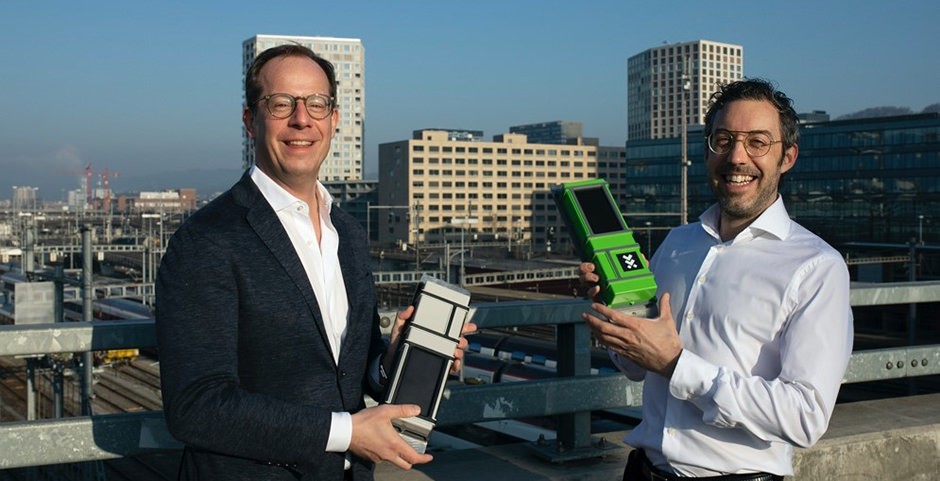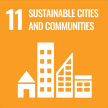
Rail is undoubtedly one of the most environmentally friendly methods of transporting goods. However, just because cargo is sent by freight car does not mean the system is efficient. “Freight cars that are not in use are pulled around empty either because they are collecting something or because they are being taken somewhere to be stored. But empty journeys are inefficient and waste both electricity and time,” says Daniel MacGregor, co-founder of Nexxiot, a spin-off from the Swiss Federal Institute of Technology (ETH Zürich) and winner of this year’s Swisscom IoT Climate Award.
Using the Internet of Things (IoT), the Swiss firm wants to make goods transportation more efficient and more sustainable across the world. It therefore developed the Globehopper, a solar-powered device that is attached to a freight car or container. The Globehopper records the routes taken and sends the information in real time to Nexxiot’s cloud-based data platforms. Here, the data is analysed and more efficient routes are automatically calculated. The result: the same number of freight cars transport more cargo in a more climate-friendly way.
Better logistics thanks to IoT
Even Daniel MacGregor was surprised at the beginning by the size of the efficiency boost. “A Dutch firm had asked us to track its journeys and record how efficiently it was transporting its goods. The result was shocking and, until that point, the company itself had no idea that it had been working so inefficiently.” However, this realisation was not down to the Globehopper alone, but to all the data it had collected and to Nexxiot’s algorithms, which had led to the correct conclusions. “There is no overarching monitoring system for freight cars,” says the company’s founder. He gives an example: “If a delivery does not reach a company on time, the logistics manager starts phoning the various stations the train is supposed to have passed through with the cargo. It can sometimes take days to track it down.” Nexxiot avoids these problems by mounting the Globehopper on its customers’ freight cars, automatically analysing the data collected and showing customers how to become more efficient. Daniel MacGregor explains: “Our system means, for example, that different customers’ goods can be transported in the same freight car – something that hasn’t been done before now.”
30,000 fewer tonnes of CO2 emissions
Moving cargo from A to B generates 7% of the world’s greenhouse gas emissions, and this figure is rising. Last year, Nexxiot’s service helped save around 30,000 tonnes of CO2 in over 160 countries. The company’s success has not come by chance. “We are a very interdisciplinary team. I actually used to be a head-hunter in the finance sector. But I saw the potential of IoT and recognised that data and data analysis were becoming extremely important in the age of big data,” says Daniel MacGregor.
Tracking and data analysis create transparency
Nevertheless, the Globehopper will not be Nexxiot’s only product. MacGregor explains: “Innovation and development are part of our company’s DNA. We are always conducting research and our product range is constantly expanding and changing.” The company is currently working with the Swiss national railway operator (SBB), for example, on a project devoted to the automatic recognition of derailments, collisions and impacts that cause damage to freight cars.
So how does Nexxiot see the future of IoT? This tracking and data analysis tool provides Daniel MacGregor and his team with fascinating insider knowledge. “It makes the whole system much more transparent. In my opinion, transparency is the future of all global supply chains. Transparency is so important right up to product level that companies will soon be unable to compete unless they are transparent and in control of their data.”
Latest news about Swisscom
Subscribe to News
Contact us
Address
Swisscom
Media Relations
Alte Tiefenaustrasse 6
3048 Worblaufen
Postal address:
Postfach, CH-3050 Bern
Switzerland
Contact
Tel. +41 58 221 98 04
media@swisscom.com
Other contacts
Contributing to sustainability

SDG 7: reduced energy consumption to make buildings more energy-efficient.

SDG 11: more sustainable building management, enhanced well-being.

SDG 13: lower CO2 emissions thanks to reduced use of fossil fuels.
